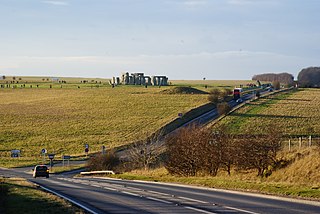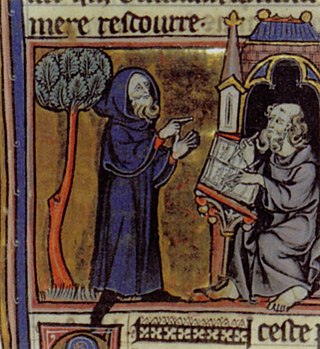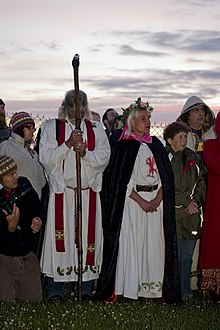
Camelot is a legendary castle and court associated with King Arthur. Absent in the early Arthurian material, Camelot first appeared in 12th-century French romances and, since the Lancelot-Grail cycle, eventually came to be described as the fantastic capital of Arthur's realm and a symbol of the Arthurian world.

The Round Table is King Arthur's famed table in the Arthurian legend, around which he and his knights congregate. As its name suggests, it has no head, implying that everyone who sits there has equal status, unlike conventional rectangular tables where participants order themselves according to rank. The table was first described in 1155 by Wace, who relied on previous depictions of Arthur's fabulous retinue. The symbolism of the Round Table developed over time; by the close of the 12th century, it had come to represent the chivalric order associated with Arthur's court, the Knights of the Round Table.

Stonehenge is a prehistoric megalithic structure on Salisbury Plain in Wiltshire, England, two miles (3 km) west of Amesbury. It consists of an outer ring of vertical sarsen standing stones, each around 13 feet (4.0 m) high, seven feet (2.1 m) wide, and weighing around 25 tons, topped by connecting horizontal lintel stones. Inside is a ring of smaller bluestones. Inside these are free-standing trilithons, two bulkier vertical sarsens joined by one lintel. The whole monument, now ruinous, is aligned towards the sunrise on the summer solstice and sunset on the winter solstice. The stones are set within earthworks in the middle of the densest complex of Neolithic and Bronze Age monuments in England, including several hundred tumuli.

Uther Pendragon (Brittonic), also known as King Uther, was a legendary King of the Britons and father of King Arthur.

Amesbury is a town and civil parish in Wiltshire, England. It is known for the prehistoric monument of Stonehenge which is within the parish. The town is claimed to be the oldest occupied settlement in Great Britain, having been first settled around 8820 BC. The parish includes the hamlets of Ratfyn and West Amesbury, and part of Boscombe Down military airfield.

The A303 is a trunk road in southern England, running between Basingstoke in Hampshire and Honiton in Devon via Stonehenge. Connecting the M3 and the A30, it is part of one of the main routes from London to Devon and Cornwall. It is a primary A road throughout its length, passing through five counties.

Avebury is a Neolithic henge monument containing three stone circles, around the village of Avebury in Wiltshire, in south-west England. One of the best-known prehistoric sites in Britain, it contains the largest megalithic stone circle in the world. It is both a tourist attraction and a place of religious importance to contemporary pagans.

The Battle of the Beanfield took place over several hours on 1 June 1985, when Wiltshire Police prevented The Peace Convoy, a convoy of several hundred New Age travellers, from setting up the 1985 Stonehenge Free Festival in Wiltshire, England. The police were enforcing a High Court injunction obtained by the authorities prohibiting the 1985 festival from taking place. Around 1,300 police officers took part in the operation against approximately 600 travellers.

The Stonehenge road tunnel is a proposed tunnel in Wiltshire, England, with the goal of moving the A303 into a tunnel under part of the Stonehenge World Heritage Site to remove road traffic from view of the stones. Various proposals have been made for a tunnel in the area since the mid 1990s, but are controversial. UNESCO has previously raised concerns that the World Heritage Site would be at risk due to the earthworks associated with a tunnel project.
The Pendragon Cycle is a series of historical fantasy books based on Arthurian legend, written by Stephen R. Lawhead. The cycle was originally planned as a four-book series, but the original publisher opted to stop after the first three books, resulting in an abrupt ending to Arthur and the existence of many unexplored stories and plotlines. The first three books were thus originally called "The Pendragon Trilogy". Lawhead moved to a new publisher a few years later. It was decided to expand on the trilogy by finishing the series, and two additional books were planned. These books, Pendragon and Grail, are set in between events covered in Arthur. Lawhead later wrote a final book Avalon, which is not considered to be a true addition to the cycle but rather a "related semi-sequel" to round out the "Once and Future King" aspect of the legend. The film and television rights to the series were purchased by DailyWire+ in November 2022.
In Arthurian legend, Mount Killaraus is a legendary place in Ireland where Stonehenge originally stood. According to the narrative presented in Geoffrey of Monmouth's Historia Regum Britanniae, King Ambrosius Aurelianus embarks on a quest to construct a memorial for the Celtic Britons who were treacherously slain by Anglo-Saxons. When conventional methods fail to produce an awe-inspiring monument, Ambrosius turns to the renowned wizard Merlin for guidance. In response, Merlin advises the king to transport a stone circle known as the Giant's Ring from Mount Killaraus in Ireland, attributing magical and healing properties to these stones, which were believed to have been brought from Africa by giants.

The A344 was an A road in the English county of Wiltshire. Until 2013 it ran from its junction with the A303 at Stonehenge, northwest to its junction with the A360, 2 miles (3 km) away.

Stonehenge has been the subject of many theories about its origin, ranging from the academic worlds of archaeology to explanations from mythology and the paranormal.

Winterbourne Stoke is a village and civil parish in Wiltshire, England, about 5 miles (8 km) west of Amesbury and 3 miles (4.8 km) west of the prehistoric monument of Stonehenge.

Stonehenge Avenue is an ancient avenue on Salisbury Plain, Wiltshire, England. It is part of the Stonehenge, Avebury and Associated Sites UNESCO World Heritage Site. Discovered in the 18th century, it measures nearly 3 kilometres, and connects Stonehenge with the River Avon. It was built during the Stonehenge 3 period of 2600 to 1700 BCE.

Merlin is a partly lost French epic poem written by Robert de Boron in Old French and dating from either the end of the 12th or beginning of the 13th century. The author reworked Geoffrey of Monmouth's material on the legendary Merlin, emphasising Merlin's power to prophesy and linking him to the Holy Grail. The poem tells of his origin and early life as a redeemed Antichrist, his role in the birth of Arthur, and how Arthur became King of Britain. Merlin's story relates to Robert's two other reputed Grail poems, Joseph d'Arimathie and Perceval. Its motifs became popular in medieval and later Arthuriana, notably the introduction of the sword in the stone, the redefinition of the Grail, and turning the previously peripheral Merlin into a key character in the legend of King Arthur.

Rollo Maughfling is the Archdruid of Stonehenge and Britain. He is a long-time campaigner for the restoration of traditional rights of access to druidic sites, and respect for ancient druidic rituals. He is also a founder member of the Council of British Druid Orders.

Druidry, sometimes termed Druidism, is a modern spiritual or religious movement that promotes the cultivation of honorable relationships with the physical landscapes, flora, fauna, and diverse peoples of the world, as well as with nature deities, and spirits of nature and place. Theological beliefs among modern Druids are diverse; however, all modern Druids venerate the divine essence of nature.

The Council of British Druid Orders is a neo-pagan group established in 1989 which was originally formed to facilitate ceremonies at Stonehenge. The council's founder, Tim Sebastion, used the title "Archdruid of Wiltshire, Chosen Chief of the Secular Order of Druids, Conservation Officer for the Council of British Druid Orders and Bard of the Gorsedd of Caer Abiri (Avebury)."


















